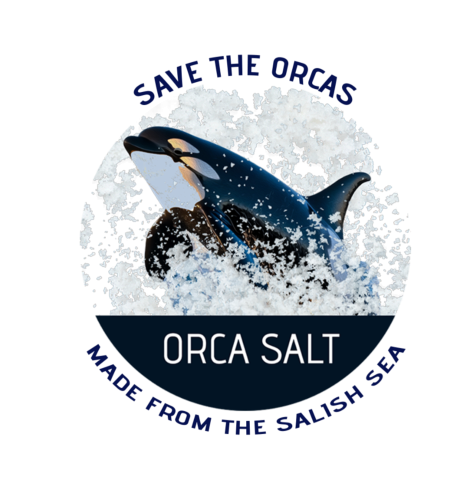THE ESSENTIAL PANTRY
ORCA WHALES
Orcas, also known as killer whales, are one of the most fascinating marine creatures in the ocean. Recognizable by their
striking black-and-white color pattern, Orcas are highly intelligent and social apex predators. They thrive in oceans
worldwide, from icy Arctic waters to warmer tropical seas. Known for their complex communication and hunting
techniques, Orcas are among the most powerful and revered creatures in the animal kingdom.
Physical Characteristics
Orca whales are large, powerful mammals with a distinct appearance. Males can grow up to 32 feet long,
while females tend to be slightly smaller. Their bodies are robust, with a distinctive black-and-white
coloration that helps them blend into the ocean’s dark depths and bright surface waters. The tall dorsal fin,
which can reach up to 6 feet in males, and their striking white patches near their eyes make them easily
identifiable. Their streamlined bodies enable them to travel fast, often reaching speeds of 30 miles per hour.
Habitat and Distribution
Orcas are found in oceans around the globe, from the cold waters of the Arctic and Antarctic to the warm seas of
the Pacific, Atlantic, and beyond. While they are most commonly found in the wild off the coasts of North
America, Europe, and New Zealand, Orcas are adaptable creatures that can thrive in a variety of marine
environments. Their diverse habitats span both coastal and offshore regions, where they hunt, socialize, and play.
Behavior and Social Structure
Orcas are highly social animals, often living in groups called pods. These pods are typically matrilineal, meaning they are
led by the oldest female in the group. Orca pods can vary in size, from just a few individuals to over 50 members,
depending on food availability and social bonds. Orcas communicate using a complex array of vocalizations, such as
clicks, whistles, and pulsed calls. These communications are vital for hunting and maintaining group cohesion during
long ocean migrations.
Diet and Hunting Techniques
As apex predators, Orcas are skilled hunters and have a varied diet. They feed on a range of marine creatures,
including fish, seals, and even other whales. Orcas are known for their unique hunting strategies, which they pass
down through generations. They often work together in coordinated hunts, using tactics such as creating waves to
knock seals off ice floes or herding fish into tight schools. These strategies highlight their intelligence and teamwork.
Conservation Status
While Orcas are not currently considered endangered, certain populations are facing threats due to environmental
changes, pollution, and depletion of their food sources. Killer whales in some regions are increasingly exposed to
toxins, such as PCBs, which accumulate in their bodies over time. Conservation efforts focus on reducing pollution,
preserving marine habitats, and ensuring sustainable fish stocks. Protecting Orca populations is crucial for
maintaining the health of marine ecosystems.
Fun Facts About Orcas
Orcas are known to have distinct "dialects" within their pods.
Why Orcas Matter
Orcas play an essential role in maintaining the balance of marine ecosystems. As top predators, they regulate the
populations of other species, ensuring healthy ocean environments. Protecting Orcas means protecting the
biodiversity of the oceans, which is critical to the overall health of our planet.
Understanding Orca Whales and the
Importance of Their Conservation.
Save the Orcas: Support Conservation with Every Sprinkle
Our oceans are calling and the Orcas need our help. These majestic, intelligent creatures are facing
increasing threats from pollution, declining food sources, and habitat loss. That’s why The Essential Pantry
has created Orca Salt a purpose-driven sea salt blend crafted from The Salish Sea to raise awareness and
directly support Orca whale conservation efforts. Visit the curators of Orca Salt,
The Essential Pantry located in University Place, WA.
Contact The Essential Pantry
(253) 541-2744
Wendy@TheEssentialPantry.com
3550 Market Place W Unit A-105
University Place, WA 98466
They have been observed hunting in creative and
cooperative ways, including working todether to create
waves to capture prey.
Despite their name, “killer whales” are not dangerous
to humans in the wild.
Orcas can live up to 90 years in the wild, with some
individuals living well into their 70s.
They are highly intelligent, with a brain size second only
to humans among marine mammals.
Orcas, also known as killer whales, are one of the
most fascinating marine creatures in the ocean.
Recognizable by their striking black-and-white
color pattern, Orcas are highly intelligent and
social apex predators. They thrive in oceans
worldwide, from icy Arctic waters to warmer
tropical seas. Known for their complex
communication and hunting techniques, Orcas are
among the most powerful and revered creatures in
the animal kingdom.
Fun Facts About Orcas
They have been observed hunting in creative
and cooperative ways, including working
together to create waves to capture prey.
Orcas can live up to 90 years in the wild, with
some individuals living well into their 70s.
They are highly intelligent, with a brain size
second only to humans among marine
mammals.
Why Orcas Matter
Orcas play an essential role in maintaining the
balance of marine ecosystems. As top predators, they
regulate the populations of other species, ensuring
healthy ocean environments. Protecting Orcas
means protecting the biodiversity of the oceans,
which is critical to the overall health of our planet.
Understanding Orca Whales and the
Importance of Their Conservation.
Save the Orcas: Support Conservation
with every sprinkle.
Our oceans are calling and the Orcas need our help.
These majestic, intelligent creatures are facing
increasing threats from pollution, declining food
sources, and habitat loss. That’s why The Essential
Pantry has created Orca Salt a purpose-driven sea
salt blend crafted from The Salish Sea to raise
awareness and directly support Orca whale
conservation efforts. Visit the curators of Orca Salt,
The Essential Pantry located in
University Place, WA.
Contact The Essential Pantry
(253) 541-2744
Wendy@TheEssentialPantry.com
3550 Market Place W Unit A-105
University Place, WA 98466




















